Table of Contents
Every day there are discussions on the wild waters of the Internet, social networks, and fitness enthusiasts around the world about the best, most effective and latest methods for the most effective muscle growth. Trends change all the time, once it is a training in the style of Arnold Schwarzenegger himself, then, according to Russell Crow for his role of Gladiator in the film of the same name or the muscular Nordic god of thunder Thor, played by Chris Hemsworth in the Avengers movies. To make matters worse, nutritional myths and half-truths keep coming back in varied forms. They once tell us that carbohydrates are friends, so that they can in an instant turn into the biggest criminals who are responsible for excess fat in people all over the world.
Then it’s no wonder that many people have absolute chaos in their questions about nutrition and training. At the same time, it is enough to follow a few simple rules that apply universally at any time, and not only when a gluten-free diet is in fashion. If you want to know what the truth about gluten is, read our article Gluten – is it really harmful to all of us?
How to set up a diet plan for muscle growth?
In recent years, the most popular fitness videos on YouTube have included content where athletes, celebrities, fitness enthusiasts and “normal mortals” shoot their diet plans throughout the day, so called “What I Eat In A Day or Full Day of Eating“. Being inspired by new recipes, meals and foods is definitely not a bad thing. But the problem arises when we try to headlessly copy these diets and hope to achieve the same goal or look like our favorite idols.
And then there are the various 10,000 kcal challenges, the original diet according to Michael Phelps and other world-famous athletes, as well as a number of instructions from bodybuilders and fitness athletes, in which they try to advise us on how to approach a diet to gain muscle. Some are better, others worse. After reading the article, we will be able to know what should inspire us and what we would rather let go unnoticed in the wild waters of the Internet.
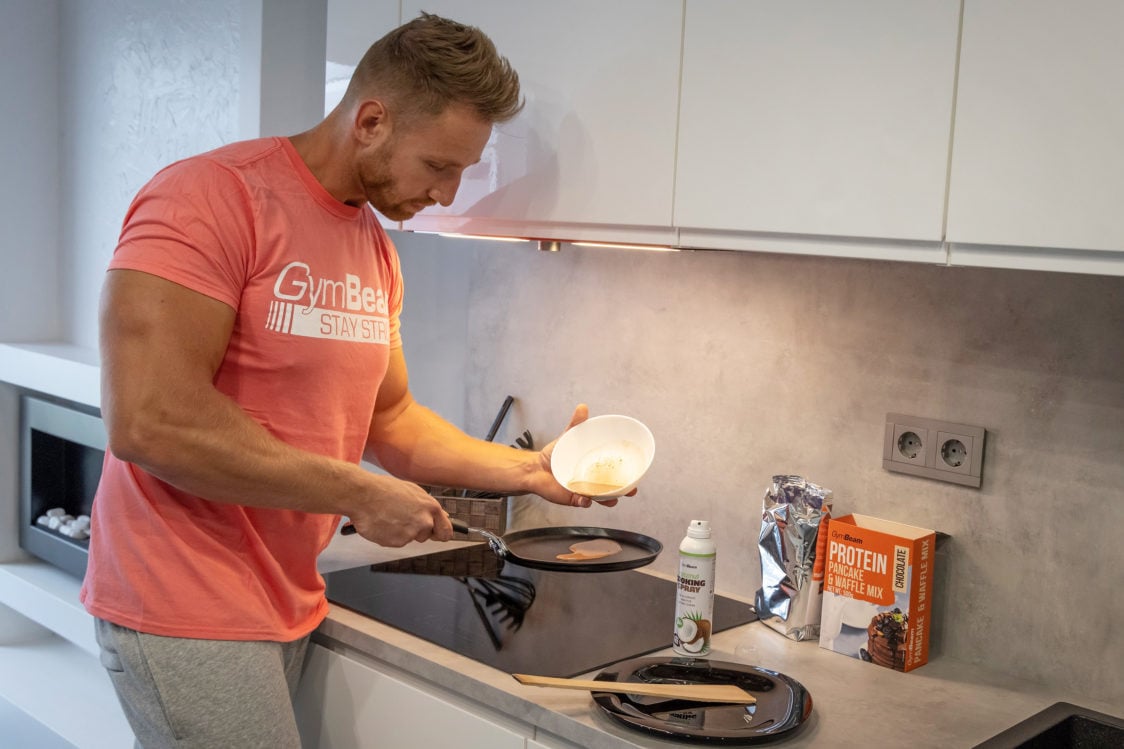
A muscle growth diet is about getting more energy from quality food, not junk food
All the pizza, burgers, Coca-Cola, sweets, and other “goodies” in some of the videos mentioned above can look quite tempting. Especially when at the end of the video we see successful athletes with a relatively low percentage of body fat. But setting up a diet on similar foods is not a good idea.
These delicacies are among the highly industrially processed foods that typically contain a lot of salt, sugar, fat, processed carbohydrates, and a lot of calories in small amounts. On the contrary, they are poor in vitamins, minerals, fiber, quality protein and at the same time have a low satiety capacity, so we can easily overeat them and receive an excessive amount of unnecessary extra energy. Many important nutrients for the optimal functioning of the body are simply lacking in such a diet, which in the long run can result in insufficient regeneration, injury and gaining unnecessarily large amounts of fat. [1] [2] [3]
Of course, having a pizza, a hamburger, a beer or a glass of wine once in a while can be fine, and in addition, such a popular “treat meal” that we don’t want to deny can help us to maintain a healthy and balanced diet in the long run. For many people, this strategy has already helped to overcome the “all in” aka “all or nothing” approach, where they ate only healthily or unhealthily for a while. We can also follow the rule, which relies on the intake of energy coming from 80% of the optimally composed diet and 20% from our “cheat foods.” If you want to learn more about the issue of “cheat meals”, read our article Cheat Meal – What it is and how works “cheating” in boarding of athletes.
What to eat to gain weight and muscle healthily?
Nothing revolutionary, after all, food from quality foods that we can imagine eating for a long time without “curling our mouths” with disgust at the mere thought of eating. We don’t have to turn our diet 180° right away and start eating foods and meals that we don’t like at all, just because they are said to be healthy and beneficial. We would endure that with self-denial for only a few days, and then we would give it all up, saying that it was priceless.
For starters, it’s a good idea to simply think about how we can improve our diet and eat more healthier foods. How about trying it like that?
| CURRENT SITUATION | SMALL IMPROVEMENT | BIGGER IMPROVEMENT | FINAL IMPROVEMENT |
|---|---|---|---|
| Fried schnitzel with French fries and mayonnaise | Fried schnitzel with American potatoes and ketchup | Roasted chicken breast with American potatoes and ketchup | Roasted breast with American potatoes, vegetable salad and a dip based on Greek yogurt |
| Sweetened cappuccino with coconut syrup and pecan plait | Cappuccino with coconut syrup and whole meal muffin | Cappuccino with 0% Greek yogurt, muesli and chocolate | Lungo with a drop of semi-skimmed milk to taste and protein pancakes with Greek yogurt, pieces of fruit and Fitcheat chocolate |
Over time, with the help of these small and inconspicuous adjustments, which are far more easily acceptable to humans, we should approach the model of the so-called a healthy plate, which is a more functional alternative to the nutrition pyramid. Thanks to it, we can easily see how each of our meals should be ideally composed in terms of the distribution of nutrients.
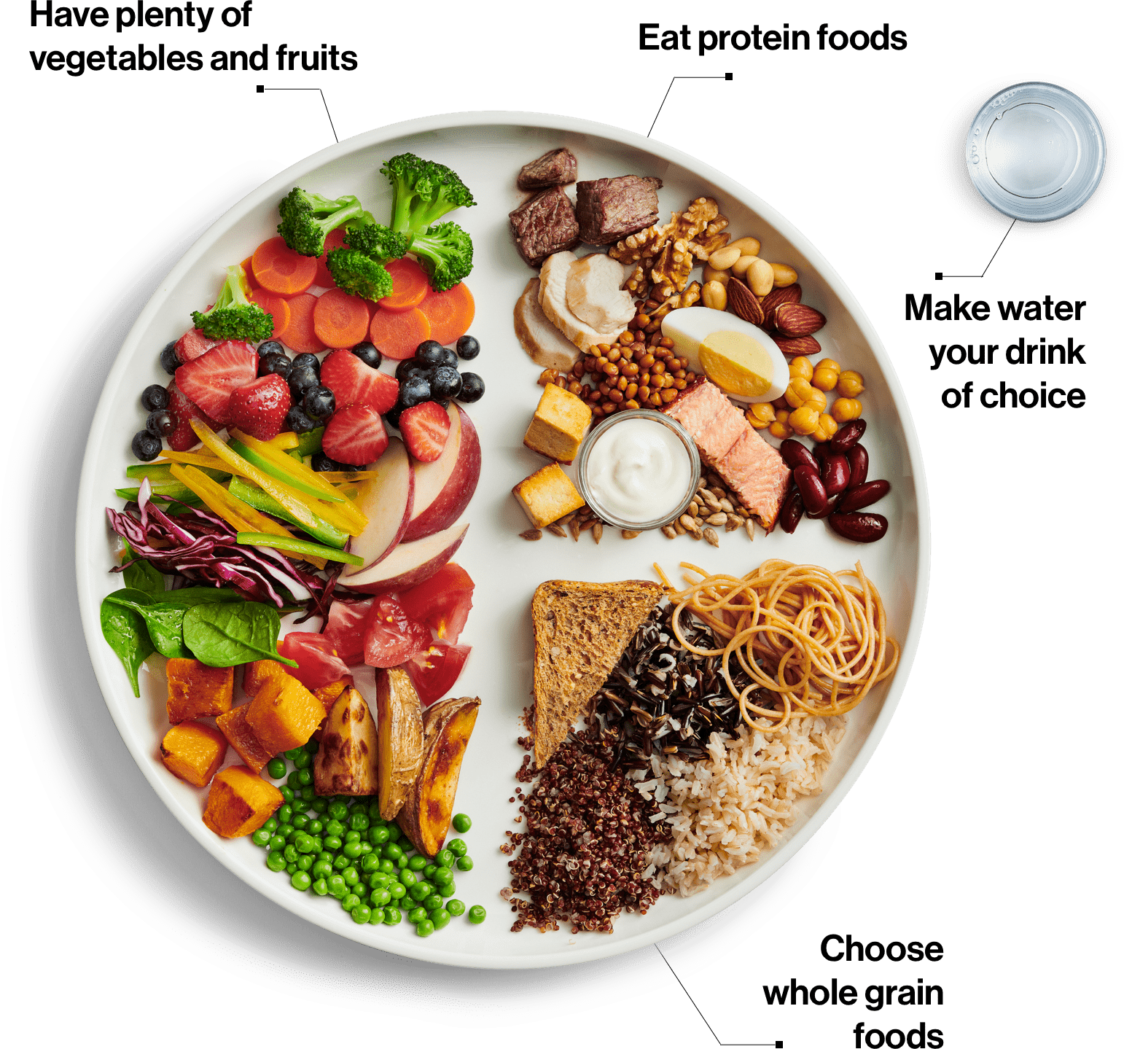
It’s quite simple on a plate, but what about different snacks?
- If it’s only a little bit possible and we have time for food, let’s put the snack on a plate as well. Carbohydrates will be represented by a slice of rye bread, protein by for example skyr, Greek yogurt 0% or protein pancakes with a layer of white yogurt and a piece of favorite fruit or a mixture of berries to it.
- If it isn’t possible, we simply prepare a snack sandwich in the form of a smaller piece of halved whole meal bread smeared with cream cheese and with two slices of ham, Edam cheese, hard-boiled egg and a favorite vegetable. Put it in a box, add another piece of sliced vegetables (kohlrabi, carrots, cucumber…) and we’re done. It’s no rocket science.
And what exactly are those proteins, fats, and carbohydrates?
- Sources of protein: meat, fish, seafood, milk, dairy products and cheese, eggs, legumes (peas, beans, all kinds of lentils, chickpeas, edamame), pseudo-cereals (buckwheat, amaranth, quinoa), tofu, tempeh, nuts, seeds, vegetable meat substitutes, delicatessen yeast, whey protein, plant-based protein, protein bars.
- Sources of fat: nuts and seeds, oils, olives, avocados, butter and other sources of fat, which are a natural part of animal proteins.
- Sources of carbohydrates: whole grains and cereals (oatmeal, flour, rice, pasta, bread and pastries), pseudo-cereals, potatoes and sweet potatoes, legumes, fruits and vegetables.
We should consume at least 400 grams of vegetables and 200 grams of fruit per day, which corresponds to 4–5, alternatively 2–3 medium-sized pieces.

3 nutritional tips for muscle growth
1. Consume more energy than before so that the muscles have something to grow from
We have already said that something like an unestablished eating of everything that comes to hand is not the right idea. We should increase our energy intake through a quality diet, by about 10–20% above our maintenance intake, when we maintain a stable body weight. Regarding calories, it would be nice to add about 250 kcal. [4] [5]
Once every 2 weeks, under the same conditions, we consider and measure the basic body circumferences, such as the circumference of the waist, hips, abdomen, chest, and others that we want to monitor. If the weight and centimeters have not moved upwards, we simply add another 250 kcal per day to the diet. As the weight or centimeters increase, we have successfully reached caloric excess and we are starting to gain muscle. It is important that the energy excess is not too great and that we do not gain an unnecessarily large amount of body fat.
How to easily add 250 kcal per day?
When we look at the picture of a healthy plate, we can imagine a simple manipulation of its composition. By increasing the carbohydrate component by about 200 grams of cooked rice, pasta, couscous and other cereals, we get the desired 250 kcal extra. We can also achieve this with, for example, a 40 gram portion of favorite nuts or a larger teaspoon of walnut butter. In case we are not able to receive energy intake for muscle growth using a solid diet, a quality gainer can help us.
If you are not sure how big your energy intake should be and how to calculate it, read our article How to calculate your energy and macronutrient intake for weight loss or muscle gain?
2. Get enough protein
In our bodies, muscle proteins break down and are formed almost constantly. In order for muscles to grow and increase their volume, it is necessary to receive enough protein per day, which stimulates the production of muscle proteins (MPS – muscle protein synthesis). How much protein is it per day? For most strength training athletes, this amount falls within a wide range of 1.4-2.0 g of protein per kilogram of body weight. For athletes weighing 70 kilograms, this represents about 98–140 grams of protein per day. The more intensely and often we train, the more protein we need. [6] [7]
And how often should we take protein?
Due to the maximum use of anabolic processes, according to the International Society for Sports Nutrition, it is ideal to eat a meal containing about 20–40 grams of quality protein every 3–4 hours. Whey or plant-based protein can help us meet our daily recommended protein intake. [7]
If you want to expand your supply of protein sources, read our article 20 foods with which you can easily add protein to your diet.
3. Include dietary supplements to help you gain muscle
- A quality gainer or meal replacement can help us increase our energy intake, especially in cases where we are unable to eat a targeted amount of energy in the form of a solid diet or for any reason we prefer a liquid diet that is more quickly absorbed.
- Whey or plant-based protein will help us meet the recommended daily protein intake and after training will turn the scales between breaking down and building muscle proteins to create them.
- Micellar casein is suitable as a nocturnal protein for the gradual and slow supply of nutrients to the muscles or when we are without food for a long time.
- Creatine is a substance that we naturally receive from our diet and our bodies make it themselves in the kidneys and liver from the amino acids glycine, arginine, and methionine. Creatine supplementation can increase body’s reserves by 20–40%, and thus provide more fast energy for explosive performance and greater strength, which can manifest itself in the form of more effective training and a stronger training stimulus. [8] [9]
- The multivitamin and multimineral formula will help us with enough of all basic micronutrients, which play an important role in almost all biological processes in our bodies.
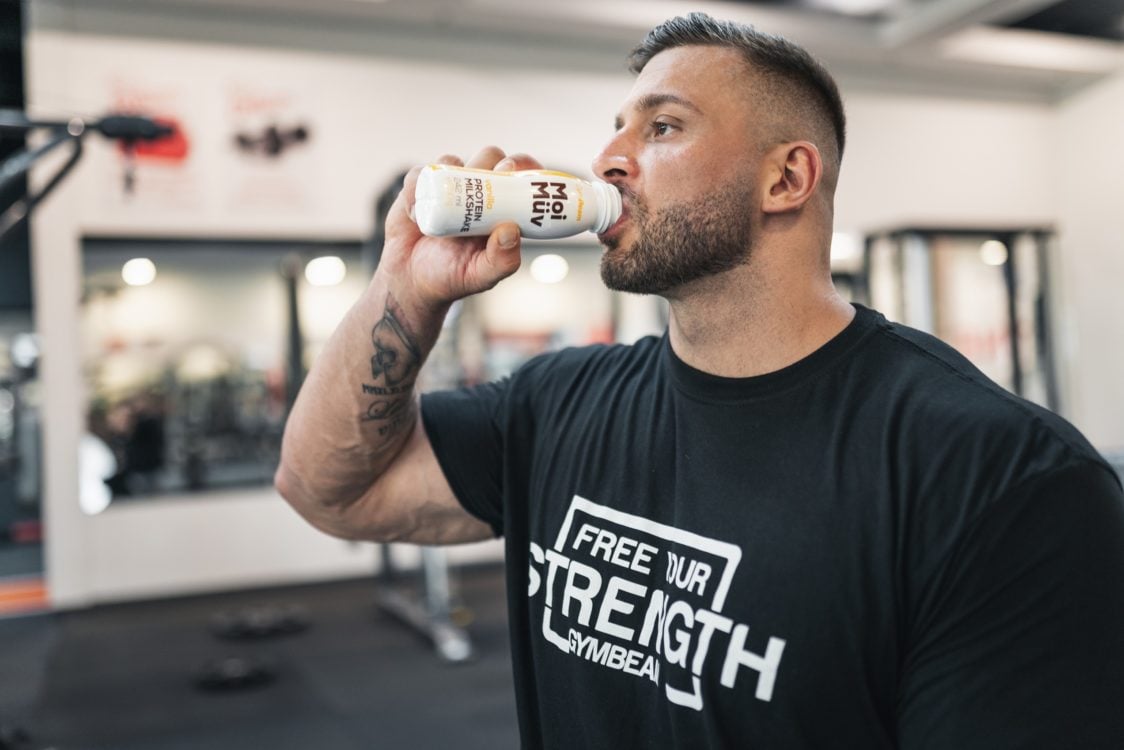
Strength training is the alpha and omega of successful muscle growth
From a nutritional point of view, the condition for successful muscle growth is a slight excess of energy and sufficient intake of proteins and micronutrients so that the body can function optimally.
The most important stimulus with respect to muscle hypertrophy is an impulse to muscle cells in the form of strength training or other sufficiently intense movement. Without exercise, the muscles simply do not want to grow, which is logical. As in life, we have no chance of learning a foreign language if we do not try. [10]
At the beginning, it really doesn’t matter if we train at home only with our own body weight or on a street workout field, we run full-body training, splits, German Volume Training or Korte training program in the gym. All of these are “mere” strength training tools that need to be learned to use. First and foremost, the most important thing is to create the conditions for strength training to be successful and translate into muscle growth.
You might be interested in these products:
6 training tips for muscle growth
1. Decide and create a training plan
When we regularly alternate time intervals of daily training within a year, followed by a break of several months, we cannot be surprised that no results are seen. Everything simply needs time. Muscles do not miraculously grow after 3 workouts with dumbbells and protein after training.
In reality, it is necessary to think about how many hours a week we are able to devote to strength training. And most importantly, we really have to make a decision and go for it. This will be important for the setting of the training plan. Complete regeneration occurs within 24–72 hours after training. Therefore, it is advisable to take this into account during the compilation of the training plan. [11] [12]
- Do we only have time twice a week? Then we choose full body training.
- Do we have time three times a week? Then we have a choice of full-body, “Upper/Lower (division of the body into top and bottom)” and a classic split with 1 muscle workout per week.
We can do the same if we want to train four times a week (“Upper/Lower” or tensile-pressure division of training).
Training well several times a week is already a relatively difficult matter for adequate regeneration. However, this requires a lot of experience and knowledge of yourself. If you want to help compile a training plan, read our article How to design a quality workout plan – tips, trainings, most common mistakes.
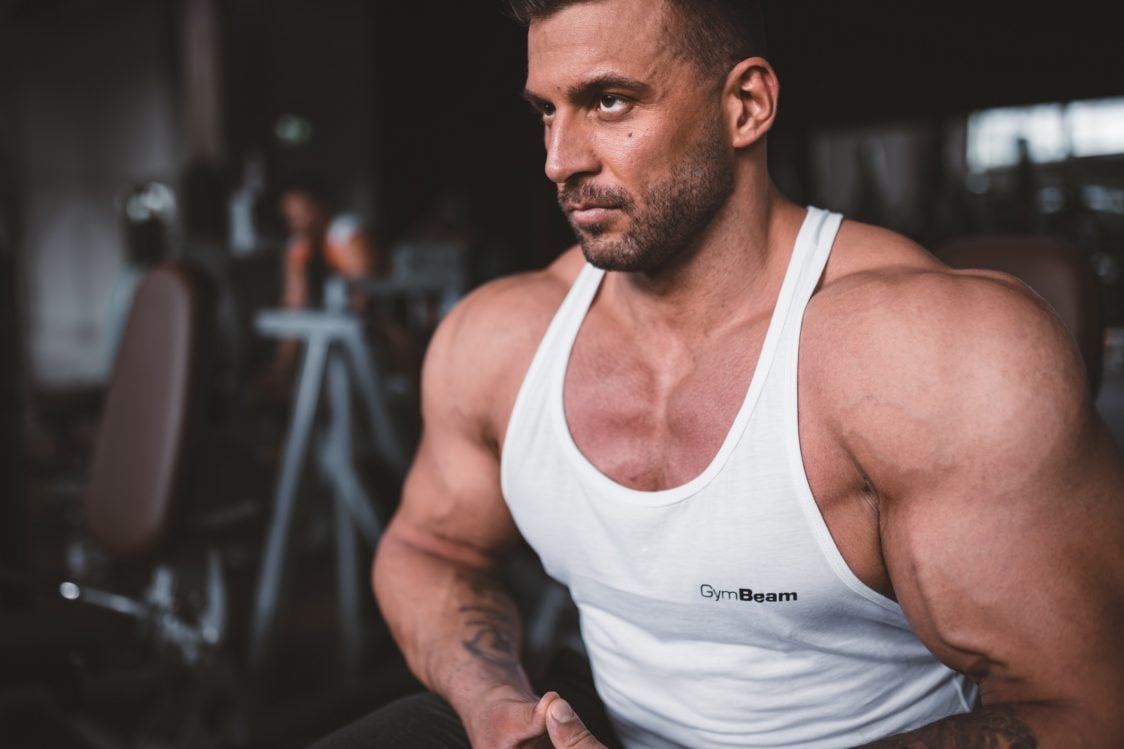
2. Build on basic exercises, create and learn a stack of exercises
What exercises are best? Those with which you have mastered the technique and suit your biomechanics of movement. We consider squats, deadlifts and bench-press to be the holy trinity of strength training. We will effectively train almost the whole body with these exercises, and if they suit us, they should definitely not be missing from the training plan.
Another point is the breakdown of individual parts into exercises that suit us, we know them, and we can practice them with the correct technique. For a start, at least 3 exercises for a large muscle part and 2 exercises for a smaller muscle part will be enough. Subsequently, we divide the exercises into a training plan according to the time possibilities.
If we do not have experience with strength training, it is definitely a good start to contact a coach, or at least a friend who has been lifting weights for some time now and will teach us the correct techniques.
3. Start with a basic number of series and repetitions with sufficient load
Due to the time required for complete regeneration, it seems appropriate to exercise one muscle part about twice a week.
We have already said that about 3 exercises for a large muscle part and 2 exercises for smaller ones in 3–4 working series will be enough. And how many repetitions is appropriate to choose in one training session? This is a range of 40–60 repetitions. We can bounce back from more powerful 4–6 repetitions in a complex exercise to “bodybuilding” 8–12 repetitions in the next exercise in 3-4 work series. [13]
In this case, the load is ideally selected between 80–85% (1RM) for 4–6 repetitions in a series and 60–75% (1RM) for 8–12 repetitions in a series. 1RM expresses the maximum weight of the load that we are able to lift with the correct technique. When we do 12 repetitions of the exercise and feel that we have a few more in reserve, it is time to add to the load to achieve the optimal growth impulse.
4. Plan, strategically increase the load and deload once in a while
The more trained we are, the easier the lifted weight is for us. Therefore, it is necessary to take this factor into account within the mesocycle (medium-term time period of training) and make the training a bit more demanding every week by adding to the number of repetitions or a longer time under tension (TUT). As part of training planning, we should increase the load in a mesocycle lasting about 4-8 weeks. [10] [14] [15]
After this mesocycle, it would be time for a weekly deload phase, when we reduce the intensity of the training by about half due to less load on the barbell or the number of done series. This will achieve the full manifestation of training adaptations. We can simply reduce the load on the barbell or the number of drilled series. [15]
After this block, we will test our 1RM again and plan another training load accordingly. We force the muscles to grow so that the training will respect the progressive overload when the individual training blocks are becoming more and more demanding and the muscles receive a stronger growth impulse.
And what should be the pause between the series? Approximately 3 minutes between the heaviest series and 2 minutes between the lighter series to adequately restore energy resources for further muscle work. [16]
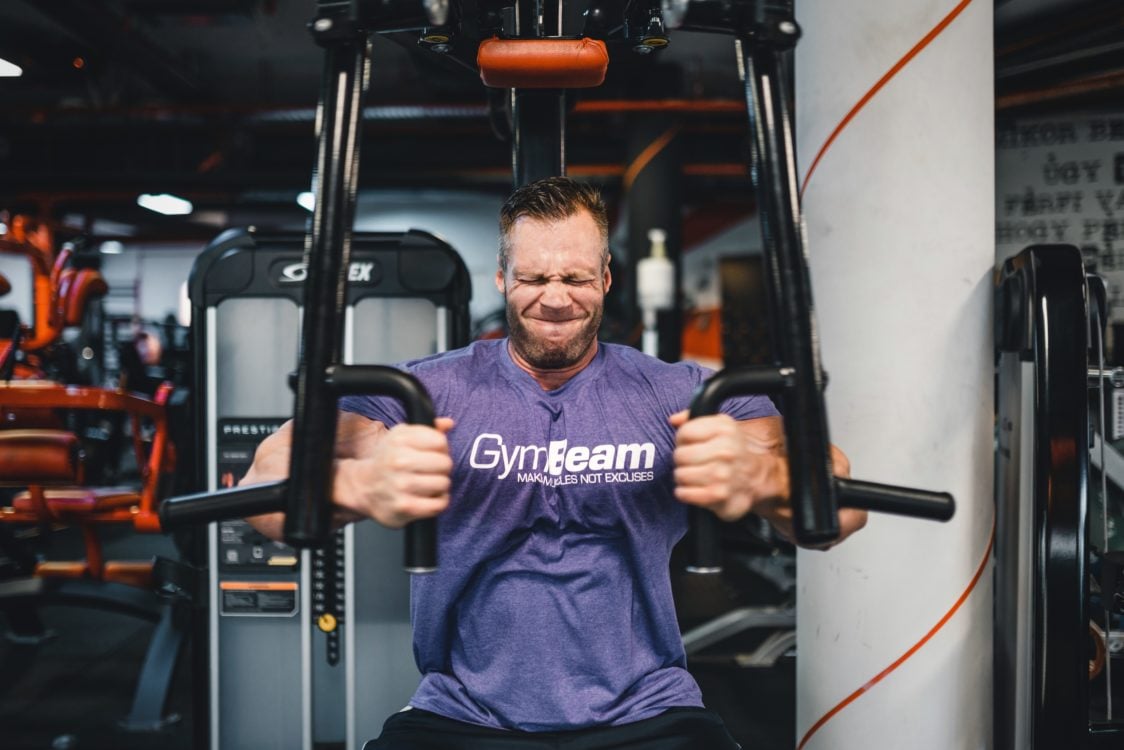
5. Be patient and persistent
Not even Rome was built in a day, Michelangelo did not carve the statue of David overnight, so we must accept the fact that everything has its time. It is necessary to trust the set process, monitor progress and cleverly adjust the plan according to the output of medium-term goals. This means that we can make partial changes to the training plan after about a month of careful and patient work. Of course, we do not include manipulating the size of the load with respect to the goal of achieving progressive overload.
There is also a huge difference in what starting position we are in. The beginner grows literally from just looking at the barbell and the advanced to experienced strength athlete is happy for every 100 grams of new muscle mass. We each have natural potential elsewhere. And that needs to be respected and understood.
If you are interested in how to set your goals and mind correctly for success, read our article You aren’t seeing results from diet and hard work at the gym? We will tell you how to succeed!
6. Don’t underestimate sleep and enough time to regenerate
Sleep is a powerful wizard, whose secrets are gradually revealed to us and their wide range of work continues to surprise us. Optimal sleep is important for maintaining good cognitive function, stress management, eliminating fatigue, healthy testosterone levels and an overall favorable hormonal environment for muscle growth. [17]
An excessive training load usually does not transform into better results either. On the contrary. Let’s respect the training process and train hard enough. Then it is time for rest and quality regeneration, for example in the form of massages, cold therapy, sauna, and other techniques.
If you are interested to know more about nutrition in the period around training, read our article What to eat before and after a workout to reach maximum results.
Factors that need to be met for muscle growth:
- A slight excess of energy in the diet, about 10–20% in addition to the maintenance energy intake.
- Daily intake of sufficient protein in a wide range of 1.4–2 g per kg body weight.
- A quality training plan respecting the principle of progressive overload, which can be supported by increasing the training volume, higher training intensity, shortening the rest interval between sets or slowing down the pace of exercise. [18]
- Sufficient space for the regeneration of muscles and the nervous system, which is also exhausted by demanding training. [19] [20]
- Sleep at least 7–9 hours a day.
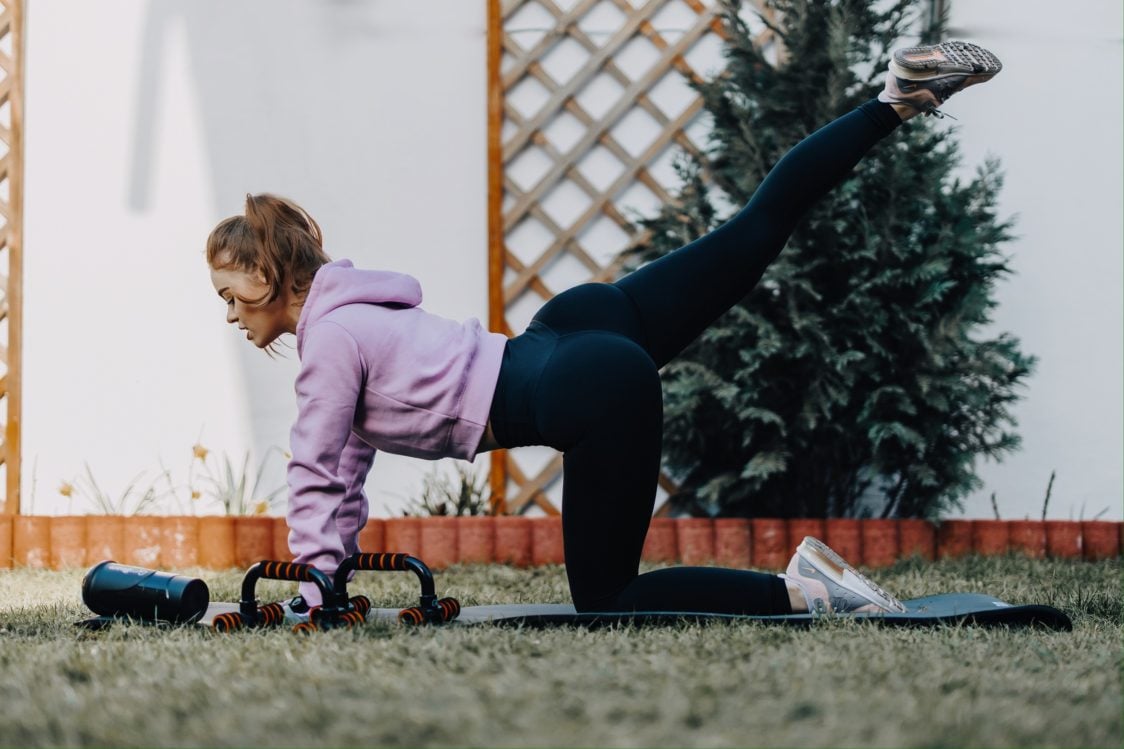
What to take from it?
Meeting the conditions for muscle growth is not as complicated as it might seem, is it? We don’t need any shortcuts, accelerators, groundbreaking training methods or miraculous pills. Just follow some of the most important variables for muscle growth, progress and most importantly be patient and consistent. Even if we don’t want to work out, only the nice post-workout feeling thanks to endorphins will push us into the gym.
Building muscle is a matter of months, years, but in fact it can be a matter of a whole training career. But it depends on our ambitions and goals. For an attractive muscular figure, it is enough to exercise for a long time about 3 times a week, eat a quality balanced diet with enough of all nutrients, sleep enough and not stress unnecessarily.
If you liked the article and it was beneficial for you, we will be happy if you share it, so you can help other readers with setting up a diet and training for muscle growth. What helped you build muscle mass? Share with us your advice and tips in the comments.
[1] Kevin Hall, D., Ayuketah, A., Brychta, R., Cai, H., Cassimatis, T., Chen, K. Y., Chung, S. T., Costa, E., Courville, A., Darcey, V., Fletcher, L. A., Forde, C. G., Gharib, A. M., Guo, J., Howard, R., Joseph, P. V., McGehee, S., Ouwerkerk, R., Raisinger, K., … Zhou, M. – Ultra-Processed Diets Cause Excess Calorie Intake and Weight Gain: An Inpatient Randomized Controlled Trial of Ad Libitum Food Intake – https://doi.org/10.1016/j.cmet.2019.05.008
[2] Phill B. Maffetone, & Laursen, P. B. – Athletes: Fit but Unhealthy? – https://doi.org/10.1186/s40798-016-0048-x
[3] Jean-Claude Moubarac, Batal, M., Louzada, M. L., Martinez Steele, E., & Monteiro, C. A. – Consumption of ultra-processed foods predicts diet quality in Canada – https://doi.org/10.1016/j.appet.2016.11.006
[4] Alan A. Aragon, Schoenfeld, B. J., Wildman, R., Kleiner, S., VanDusseldorp, T., Taylor, L., Earnest, C. P., Arciero, P. J., Wilborn, C., Kalman, D. S., Stout, J. R., Willoughby, D. S., Campbell, B., Arent, S. M., Bannock, L., Smith-Ryan, A. E., & Antonio, J. – International society of sports nutrition position stand: Diets and body composition – https://doi.org/10.1186/s12970-017-0174-y
[5] Alan A. Aragon, & Schoenfeld, B. J. – Magnitude and Composition of the Energy Surplus for Maximizing Muscle Hypertrophy: Implications for Bodybuilding and Physique Athletes – https://doi.org/10.1519/SSC.0000000000000539
[6] Kevin D. Tipton, Hamilton, D. L., & Gallagher, I. J. – Assessing the Role of Muscle Protein Breakdown in Response to Nutrition and Exercise in Humans – https://doi.org/10.1007/s40279-017-0845-5
[7] Ralf Jäger, Kerksick, C. M., Campbell, B. I., Cribb, P. J., Wells, S. D., Skwiat, T. M., Purpura, M., Ziegenfuss, T. N., Ferrando, A. A., Arent, S. M., Smith-Ryan, A. E., Stout, J. R., Arciero, P. J., Ormsbee, M. J., Taylor, L. W., Wilborn, C. D., Kalman, D. S., Kreider, R. B., Willoughby, D. S., … Antonio, J. – International Society of Sports Nutrition Position Stand: Protein and exercise – https://doi.org/10.1186/s12970-017-0177-8
[8] Thomas W. Buford, Kreider, R. B., Stout, J. R., Greenwood, M., Campbell, B., Spano, M., Ziegenfuss, T., Lopez, H., Landis, J., & Antonio, J. – International Society of Sports Nutrition position stand: Creatine supplementation and exercise – https://doi.org/10.1186/1550-2783-4-6
[9] Richard B. Kreider, Kalman, D. S., Antonio, J., Ziegenfuss, T. N., Wildman, R., Collins, R., Candow, D. G., Kleiner, S. M., Almada, A. L., & Lopez, H. L. – International Society of Sports Nutrition position stand: Safety and efficacy of creatine supplementation in exercise, sport, and medicine – https://doi.org/10.1186/s12970-017-0173-z
[10] Brad Schoenfeld – The Mechanisms of Muscle Hypertrophy and Their Application to Resistance Training – https://doi.org/10.1519/JSC.0b013e3181e840f3
[11] Nicholas A. Burd, West, D. W. D., Moore, D. R., Atherton, P. J., Staples, A. W., Prior, T., Tang, J. E., Rennie, M. J., Baker, S. K., & Phillips, S. M. – Enhanced amino acid sensitivity of myofibrillar protein synthesis persists for up to 24 h after resistance exercise in young men – https://doi.org/10.3945/jn.110.135038
[12] Jozo Grgic, Schoenfeld, B. J., Davies, T. B., Lazinica, B., Krieger, J. W., & Pedisic, Z. – Effect of Resistance Training Frequency on Gains in Muscular Strength: A Systematic Review and Meta-Analysis – https://doi.org/10.1007/s40279-018-0872-x
[13] Daniel A. Hackett, Amirthalingam, T., Mitchell, L., Mavros, Y., Wilson, G. C., & Halaki, M. – Effects of a 12-Week Modified German Volume Training Program on Muscle Strength and Hypertrophy—A Pilot Study – https://doi.org/10.3390/sports6010007
[14] Roberto Simão, Spineti, J., de Salles, B. F., Matta, T., Fernandes, L., Fleck, S. J., Rhea, M. R., & Strom-Olsen, H. E. – Comparison between nonlinear and linear periodized resistance training: Hypertrophic and strength effects – https://doi.org/10.1519/JSC.0b013e318231a659
[15] The Barbell Physio – The Most Overlooked Training Variable: Training Volume – https://thebarbellphysio.com/overlooked-training-variable-training-volume/
[16] Menno Henselmans, M., & Schoenfeld, B. J. – The effect of inter-set rest intervals on resistance exercise-induced muscle hypertrophy – https://doi.org/10.1007/s40279-014-0228-0
[17] Rafael Luboshitzky, Zabari, Z., Shen-Orr, Z., Herer, P., & Lavie, P. – Disruption of the nocturnal testosterone rhythm by sleep fragmentation in normal men – https://doi.org/10.1210/jcem.86.3.7296
[18] Kraemer, W. J., Adams, K., Cafarelli, E., Dudley, G. A., Dooly, C., Feigenbaum, M. S., Fleck, S. J., Franklin, B., Fry, A. C., Hoffman, J. R., Newton, R. U., Potteiger, J., Stone, M. H., Ratamess, N. A., Triplett-McBride, T., & – American College of Sports Medicine position stand. Progression models in resistance training for healthy adults – https://doi.org/10.1097/00005768-200202000-00027
[19] Kenneth C. Vitale, Owens, R., Hopkins, S. R., & Malhotra, A. – Sleep Hygiene for Optimizing Recovery in Athletes: Review and Recommendations – https://doi.org/10.1055/a-0905-3103
[20] Adam Zając, Chalimoniuk, M., Maszczyk, A., Gołaś, A., & Lngfort, J. – Central and Peripheral Fatigue During Resistance Exercise—A Critical Review – https://doi.org/10.1515/hukin-2015-0118

Add a comment
You must be logged in to post a comment.